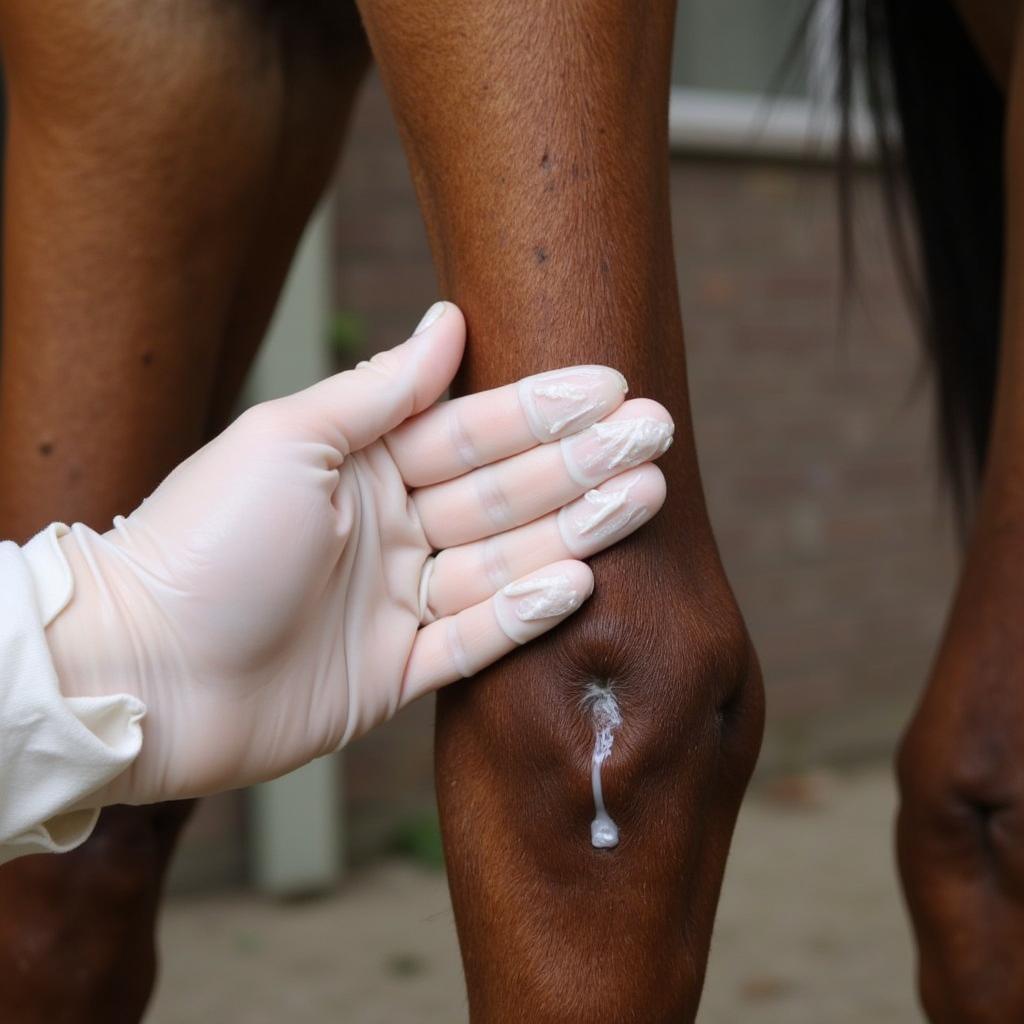Cracked Heels In Horses, also known as heel cracks, mud fever, greasy heel, or scratches, are a common and frustrating condition. They present as painful fissures or cracks in the skin of the pastern, often extending to the heel bulbs. This condition can range from mild dryness to deep, infected cracks, causing significant discomfort and lameness in horses. Understanding the causes, treatment, and preventative measures is crucial for any horse owner.
Just after the fetlock joint, the skin around the pastern and heel is particularly susceptible to cracking, especially during wet or muddy conditions. The constant exposure to moisture softens the skin, making it prone to damage. Besides environmental factors, there are several other contributing elements that can lead to cracked heels. Let’s explore them further.
Understanding the Causes of Cracked Heels
Cracked heels can stem from a variety of factors, often working in combination. Wet and muddy conditions are a primary culprit, as they soften the skin and create an ideal breeding ground for bacteria and fungi. Poor stable hygiene, infrequent cleaning of the lower legs, and prolonged exposure to irritants like urine and manure can also contribute to the problem. Individual horse susceptibility also plays a role, with some horses having thinner skin or being more prone to allergic reactions that exacerbate the condition.
Beyond environmental factors, other contributing causes can include:
- Parasites: Mites and other parasites can cause itching and inflammation, leading to self-trauma and subsequent cracking.
- Bacterial and fungal infections: Once the skin is compromised, bacteria and fungi can easily invade, deepening the cracks and causing infection.
- Allergic reactions: Sensitivities to certain bedding materials, topical products, or even feed can manifest as skin irritation and cracking.
- Nutritional deficiencies: A lack of essential vitamins and minerals can weaken the skin’s integrity, making it more susceptible to cracking.
After a long ride in muddy terrain, ensuring your horse’s legs are clean and dry is paramount. This simple practice can significantly reduce the risk of cracked heels. Check out our range of horse ointment cream for effective treatment options.
Effective Treatment Options for Cracked Heels
Treatment for cracked heels depends on the severity of the condition. Mild cases may respond well to simple cleansing and application of a protective barrier cream. More severe cases, particularly those involving infection, may require veterinary intervention with topical or systemic medications.
Here’s a step-by-step guide to treating cracked heels:
- Cleanse the affected area: Gently wash the pastern and heel with warm water and a mild antiseptic soap. Avoid harsh scrubbing, which can further irritate the skin.
- Dry thoroughly: Pat the area dry with a clean towel. Ensure all moisture is removed, as dampness perpetuates the problem.
- Apply a topical treatment: A variety of creams and ointments are available to soothe and protect the skin. Consult your veterinarian for recommendations.
- Keep the area clean and dry: Maintain a clean and dry environment for your horse. Consider using bandages or protective boots to keep the area clean and free from further irritation.
For deeper cracks or infected areas, your veterinarian may prescribe antibiotics or antifungal medications. In severe cases, debridement (surgical removal of damaged tissue) might be necessary. Remember, prompt treatment is key to preventing complications and ensuring a speedy recovery. For durable and comfortable footwear for your equine companion, explore our selection of boots for riding horses.
Preventing Cracked Heels: Proactive Measures
Preventing cracked heels is always better than treating them. Here are some proactive steps you can take to protect your horse:
- Maintain good stable hygiene: Regularly clean stalls and remove manure and wet bedding to minimize bacterial and fungal growth.
- Keep legs clean and dry: Wash and thoroughly dry your horse’s legs after exposure to mud or wet conditions.
- Apply a barrier cream: Use a protective barrier cream, especially during wet seasons, to prevent moisture from softening the skin.
- Provide adequate nutrition: Ensure your horse’s diet is balanced and provides essential vitamins and minerals for healthy skin.
- Regularly inspect hooves and legs: Frequent inspections can help identify early signs of cracking and allow for prompt treatment.
 Horse with bandaged legs standing in a clean stall
Horse with bandaged legs standing in a clean stall
Dr. Emily Carter, DVM, a renowned equine veterinarian, advises, “Regular hoof care and attention to leg hygiene are crucial for preventing cracked heels. Early intervention is key to successful treatment.” Additionally, Dr. Carter emphasizes the importance of consulting a veterinarian for persistent or severe cases.
Conclusion: Keeping Your Horse’s Heels Healthy
Cracked heels in horses, though a common ailment, can be effectively managed and prevented with proper care and attention. By understanding the underlying causes and implementing proactive preventative measures, you can ensure your horse’s comfort and well-being. Regular cleaning, maintaining dry conditions, and prompt treatment are essential for healthy heels.
 Applying ointment to a horse's heel with gloved hand
Applying ointment to a horse's heel with gloved hand
You may also find our article on horse drawn carriage wheels interesting. Carriage driving, while a different discipline, shares the importance of meticulous hoof and leg care for the horse’s overall health.
FAQ
-
What are the first signs of cracked heels?
Dryness, redness, and small cracks in the skin of the pastern and heel. -
Can I treat cracked heels myself?
Mild cases can be treated at home, but consult a vet for severe or persistent cases. -
How long does it take for cracked heels to heal?
Healing time varies depending on the severity, but generally takes several weeks with consistent care. -
What is the best cream for cracked heels in horses?
Consult your veterinarian for recommendations tailored to your horse’s specific needs. -
How can I prevent cracked heels in my horse?
Maintain good stable hygiene, keep legs clean and dry, and use a barrier cream. -
Are cracked heels contagious?
While not directly contagious, the underlying conditions (like fungal infections) can be. -
Can cracked heels cause lameness?
Yes, severe cases can cause pain and lameness, limiting the horse’s ability to move comfortably.
Common Scenarios and Questions:
-
Scenario: My horse has developed small cracks in his heels after a particularly muddy ride. What should I do?
-
Answer: Clean and dry the affected area thoroughly and apply a barrier cream. Monitor for signs of infection and consult a vet if the condition worsens.
-
Scenario: My horse has deep, infected cracks in his heels. What is the best course of action?
-
Answer: Consult your veterinarian immediately. They may prescribe antibiotics or antifungal medications.
Further Reading and Resources:
For more information on equine health and wellness, explore our other articles on Justus Horses USA. You may find articles on hoof care and skin conditions helpful.
Need Help?
For further assistance or if you have any concerns about your horse’s health, please contact us:
Phone: 0772127271
Email: [email protected]
Address: QGM2+WX2, Vị Trung, Vị Thuỷ, Hậu Giang, Việt Nam.
Our customer service team is available 24/7 to assist you.